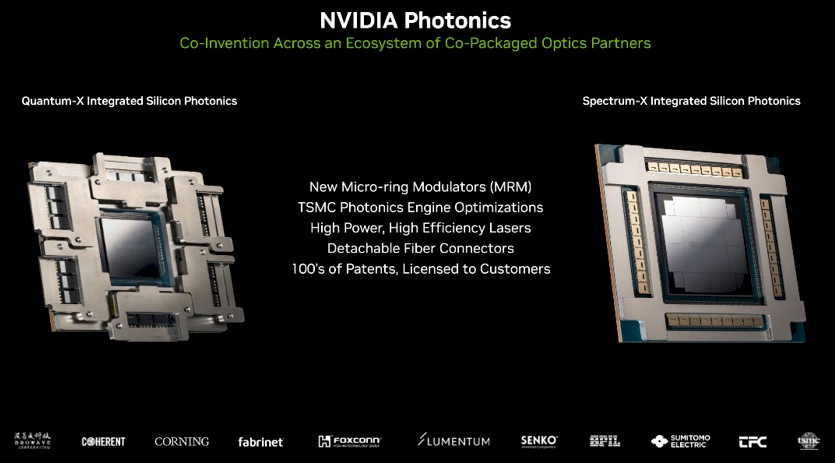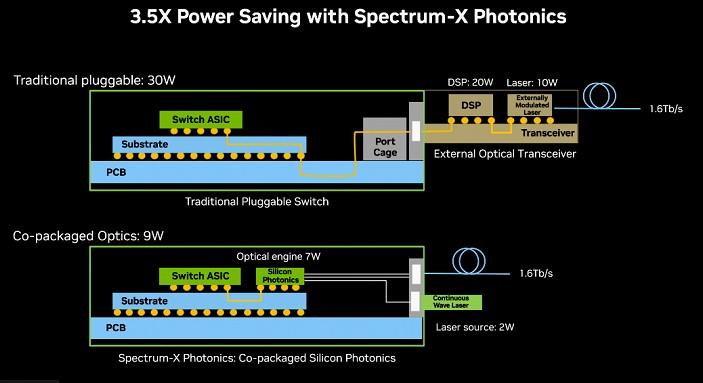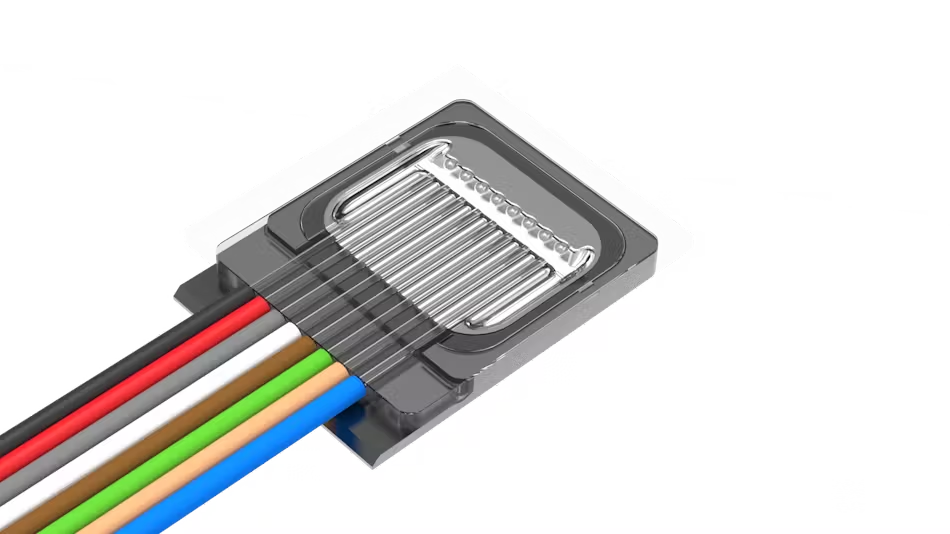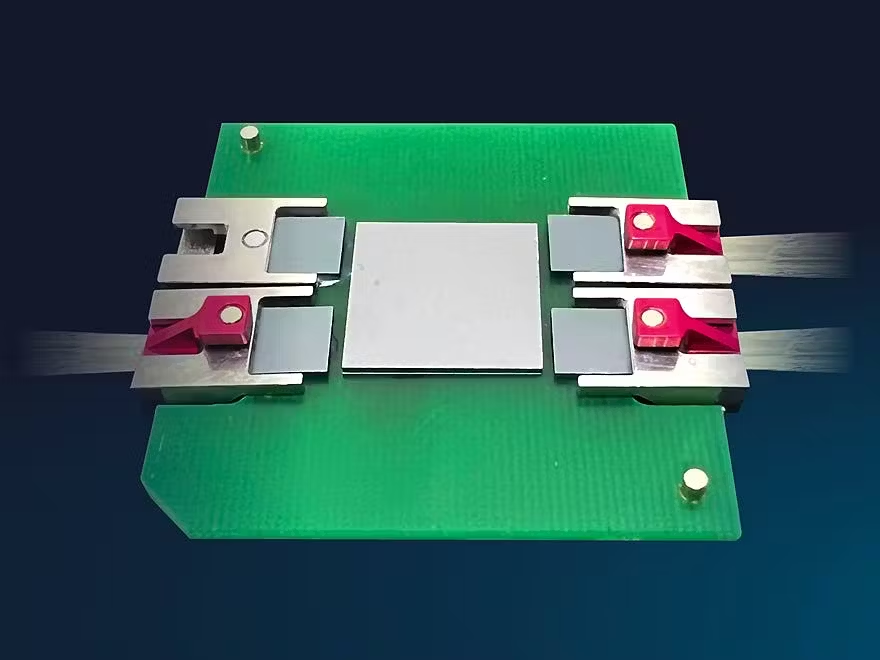optical_io
by Andy Sun (achoenix@gmail.com)
Last update: 2025/10/04
Site Navigation
- Homepage
- Silicon Photonics
- Co-Packaged Optics
- Optical Interposer
- Optical Transceiver
- AI Chip
- System Design
License & Citation
Co-Packge Optics (CPO)
Different CPO implementations
NVIDIA
The follow analysis is based on GTC 2025 keynote presented by Jensen Huang.

Quantum-X InfiniBand Switch ASIC with CPO
Plan to ship in 2025H2
Features
- 6 CPO socket per GPU (B200/B300?), closer to a NPO concept
- 3 optical engines in each socket
- SerDes running at 224Gb/s per lane with 24Gb as error correction overhead thus 200Gb/s net data rate
- SerDes per ASIC have 72 lanes
- liquid cooling for both the switch core and all optical modules
- 28.8Tbps full duplex bandwidth per switch
- 6 optical subassembly integrated on the switch package’s interposer
- 4.8Tbps of transmit and 4.8Tbps of receive per optical subassembly
- 3 optical engines per optical subassembly
Q3450 System
- 4 Quantum-X chips—provides 115.2Tbps full-duplex bandwidth over 144 ports with 800Gbps
An in-depth analysis is here: NVIDIA Quantum-X CPO
Spectrum-X Ethernet Switch ASIC with CPO (GTC 2025 Keynote)
Plan to ship in 2026H2
Features
- multi-chip module package
- the Ethernet switch ASIC has a monolithic packet processing engine
- 8 SerDes chiplets (two per side)
- 4 unknown chiplets at the corners
- 8 optical engines on each side, i.g. a total of 32 OEs
- each optical engine may support at least 1.6Tb/s (equal to the optical engine in Quantum-X)
- same 200Gb/s SerDes, 144 lanes pre ASIC
- liquid cooled
Interconnect Design
Power savings compared to pluggable transeivers
- Pluggable: 30W \@ 1.6Tb/s, i.e. 18.75 pJ/bit
- CPO: 9W \@ 1.6Tb/s, i.e. 5.625 pJ/bit (the optical engine exclude CW laser is 4.375 pJ/bit *)

* CW laser power consumption estimation: assuming 12mW is fed to each modulator channel, i.e. 80mW for 8 channels. At least two optical coupling in the link which introduces ~5dB loss, i.e. ~300mW laser output power is required. Assuming the wall-plug efficiency of the laser is ~15% (uncooled at 55C), the laser power is ~2W. Assuming the laser is uncooled and the laser driver has a ~60% conversion efficiency, the overall power of is ~3W, i.e.g ~2 pJ/bit for 1.6Tb/s.
Optical Engine
Ref: NVidia Blog
OE for Quantum-X
- 1.6Tbps PAM4 per OE
- 8 Tx and 8 Rx 200Gbps PAM4 channels, 2 laser input fibers per optical engine
- 200Gbps PAM4 microring modulator per wavelength
- multi-row scaling of optical interconnect throughput within a single package
- Stacked CMOS and photonics components
- Wafer-level integration of micro-lenses
OE for Spectrum-X
- 3.2Tbps PAM4 per OE
- 16 Tx and 16 Rx 200Gbps PAM4 channels, ? laser input fibers per OE
- 200Gbps PAM4 microring modulator per wavelength
- solder reflown directly onto the module substrate
- Stacked CMOS and photonics components
- Wafer-level integration of micro-lenses
- detachable optical connector
Challegnes Solved by TSMC
- precise control of the fabrication process
- mitigation of thermal sensitivity
- consistent high-speed modulation
External Laser
Ref: NVidia Blog
Features
- 8 lasers per ELS module
- Quantum-X switch
- 1ELS -> 8 lasers -> 32 lanes: 1 laser per 4-lane
- 4.5 ELS modules per ASIC
- 18 ELS per System (4 ASIC)
- Spectrum-X Switch
- 16 ELS modules per ASIC
- 64 ELS modules per system (4 ASIC)
Challenges Solved
- own dedicated, thermally controlled environment addresses repeated thermal cycling rapidly degrades laser lifetime
- reducing the total number of lasers in the data center by a factor of four compared to legacy designs
- implies 1 laser per 4 modulators (compared with EML), however, the same as the design for Si photonics based modules
Technical Designs
Optical Fiber Coupling
Senko

Senko develops detachable fiber connector for PIC coupling for CPO applications
Key features
- Curved micro-refector for focusing light into PIC couplers
- Variations for PIC surface (grating) and edge coupling
- Detachable
Ref
Teramount

Teramount’s TeraVERSE provides a detachable and serviceable fiber mounting socket.
Key features
- Detachable and serviceable
- Self-aligning installation
Implementation
- Fibers connected to the CPO package after all reflows
- Detachability enables in-field serviceability of faulty fibers
- Wafer-level testability of PIC
Ref